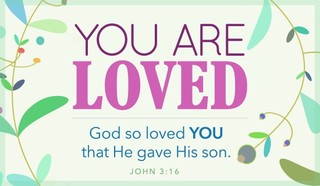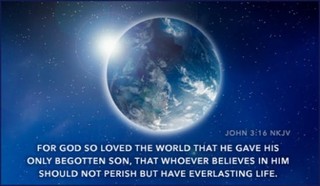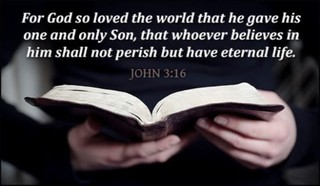- Recent Translations
- All Translations
John 3:14
Share
Settings
John 3:14 Meaning and Commentary
And as Moses lifted up the serpent in the wilderness
The history referred to is in ( Numbers 21:8 ) . There is, in many things, an agreement between this serpent, and Jesus Christ: as in the matter of it, it was a brazen serpent; it was made not of gold, nor of silver, but of brass, the meaner metal, and was a very unlikely means, of itself, to heal the Israelites; and might be despised by many: this may denote the meanness of Christ in his human nature, in his birth and parentage, and place of education and converse; and especially in his crucifixion and death; and which, to an eye of carnal sense and reason, seemed a very improbable means of saving sinners; and therefore were to some a stumbling block, and to others foolishness: though on the other hand, as brass is a shining metal, and might be chose for the serpent in the wilderness to be made of, that by the lustre of it the eyes of the Israelites might be attracted and directed to it, who were at the greatest distance in the camp; so it may be expressive of the glory of Christ, as the only begotten of the Father, and who is the brightness of his Father's glory; and which is the great attractive, motive, and inducement to engage souls to look unto him, and believe in him, ( Isaiah 45:22 ) ; and whereas brass is both a strong and durable metal, it may signify the strength of Christ, who is the mighty God, and mighty to save; and his duration, as a Saviour, being the same today, yesterday, and for ever: likewise, the comparison between the serpent Moses lifted up, and Christ, may be observed in the form of it. The brazen serpent had the form of a serpent, but not the poison and venomous nature of one; so Christ was sent, in the likeness of sinful flesh, and was found in fashion as a man, as a sinful man, but was without sin, and was perfectly holy; and yet being in this form, was made both sin and a curse, that he might redeem his people both from sin, and from the curse of the law, by dying a death which denominated him accursed, of which the serpent was, an emblem: besides, this serpent was a fiery one; at least it looked like one of the fiery serpents, being of brass, which shone as though it burned in a furnace; and may be an emblem both of Christ's Father's wrath, which was poured out like fire upon him, and of his love to his people, which was like burning fire, the coals whereof gave a most vehement flame. Moreover, this serpent Moses made, and was ordered to make, was but "one", though the fiery serpents, with which the Israelites were bitten, were many; so there is but one Mediator between God and man; but one Saviour, in whom alone is salvation, and in no other, even Jesus Christ. To which may be added the "situation" in which this serpent was put: it was set by Moses on a pole; it was lifted up on high, that every one in the camp of Israel might see it; and may point out the ascension of Christ into heaven, and his exaltation at God's right hand there, as some think; or his being set up in the ministry of the word, and held forth and exalted there as the only Saviour of lost sinners; or rather his crucifixion, which is sometimes expressed by a lifting up, ( John 8:28 ) ( 12:32 ) . Once more, there is an agreement in the effect that followed upon the lifting up of the serpent; and which was the design of it, viz. the healing of such Israelites as were bitten by the fiery serpents, who looked to this: for as the Israelites were bitten by fiery serpents, with the poison of which they were infected, and were in danger of death, and to many of them their bitings were mortal; so men are poisoned with the venom of the old serpent the devil, by which they are subjected to a corporeal death, and are brought under a spiritual, or moral death, and are liable to an eternal one: and as these bitings were such as Moses could not cure; so the wounds of sin, through the old serpent, are such as cannot be healed by the law, moral or ceremonial, or by obedience to either; and as they were the Israelites who were convinced of their sin, and acknowledged it, and had a cure by looking to the brazen serpent; so such whom the Spirit of God convinces of sin, and to whom he gives the seeing eye of faith, these, through seeing, the Son, and looking to Jesus, as crucified and slain, receive healing by his stripes and wounds: and as those, who were ever so much bit and poisoned by the fiery serpents, or were at ever so great a distance from the pole, or had the weakest eye, yet if they could but discern the serpent on the pole, though it only appeared as a shining piece of brass, had a cure; so the greatest of sinners, and who are afar off from God, and all that is good, and who have faith but as a grain of mustard seed, or but glimmering view of Christ, of his glory, fulness, and suitableness, shall be saved by him. To add no more, this was done "in the wilderness": which may signify this world, Christ's coming into it, his crucifixion in it, and his going without the camp, bearing our reproach, or suffering without the gates of Jerusalem. It is certain, that the Jews had a notion that the brazen serpent was symbolical and figurative: Philo the Jew makes it to be a symbol of fortitude and temperance F20; and the author of the apocryphal book of Wisdom F21, calls it "a sign of salvation". They thought there was something mysterious in it: hence they say F23,
``in four places it is said, "make thee" In three places it is explained, viz. ( Genesis 6:14 ) ( Numbers 10:2 ) ( Joshua 5:2 ) , and one is not explained, ( Numbers 21:8 ) , "make thee a fiery serpent", (vryp al) , is not explained.''And elsewhere F24 they ask,
``and could the serpent kill, or make alive? But at the time that Israel looked up, and served with their hearts their Father which is in heaven, they were healed; but if not, they were brought low.''So that the look was not merely to the brazen serpent, but to God in heaven; yea, to the word of God, his essential Logos, as say the Targumists on ( Numbers 21:9 ) . The Jerusalem Targum paraphrases the words thus:
``and Moses made a serpent of brass, and put it upon a high place, and whoever was bitten by the serpents, and lift up his face, in prayer, to his Father which is in heaven, and looked upon the serpent of brass, lived.''And Jonathan ben Uzziel paraphrases them thus:
``and Moses made a serpent of brass, and put it upon a high place; and it was, when a serpent had bitten any man, and he looked to the serpent of brass, "and directed his heart", (yyd armym Mwvl) , "to the name of the word of the Lord", he lived.''And this healing they understand not only of bodily healing, but of the healing of the soul: for they observe F25, that
``as soon as they said, "we have sinned", immediately their iniquity was expiated; and they had the good news brought them "of the healing of the soul", as it is written, "make thee a seraph"; and he does not say a serpent; and this is it: "and it shall come to pass, that every one that is bitten, when he looketh upon it, shall live", (vpnh tawpr) , "through the healing of the soul":''yea, they compare the Messiah to a serpent; for so the Targum on ( Isaiah 14:29 ) paraphrases that passage:
``the Messiah shall come forth from Jesse's children's children; and his works shall be among you as a "flying serpent".''And who else can be designed by the "other serpent of life" F26, and the "holy serpent" F1 they speak of, in opposition to the evil serpent that seduced Eve? And it is well known, that (vxn) , "a serpent", and (xyvm) , "Messiah", are numerically, or by gematry, the same; a way of interpretation, and explanation, often in use with the Jews. Now, as this serpent was lifted up on a pole on high, that every one that was bitten with the fiery serpent might look to it, and be healed;
even so must the son of man be lifted up;
upon the cross, and die: the crucifixion and death of Christ were necessary, and must be, because of the decrees and purposes of God, by which he was foreordained thereunto, and by which determinate counsel he was delivered, taken, crucified, and slain; and because of his own engagements as a surety, laying himself under obligations in the council and covenant of peace, to suffer, and die, in the room of his people; and because of the prophecies in the Old Testament, and his own predictions, that so it should be; as also, that the antitype might answer the type; and particularly, that he might be a suitable object of faith for wounded sinners, sensible of sin, to look unto.
F20 De Agricult. p. 202. & Allegor. l. 3. p. 1101, 1102, 1103, 1104.
F21 C. 16. v. 6.
F23 T. Hieros. Roshhashanah, fol. 59. 1.
F24 Misn. Roshhashanah, c. 3. sect. 3.
F25 Tzeror Hammor, fol. 123. 2.
F26 Zohar in Gen fol. 36. 2.
F1 Tikkune Zohar in Jetzira, p. 134.


